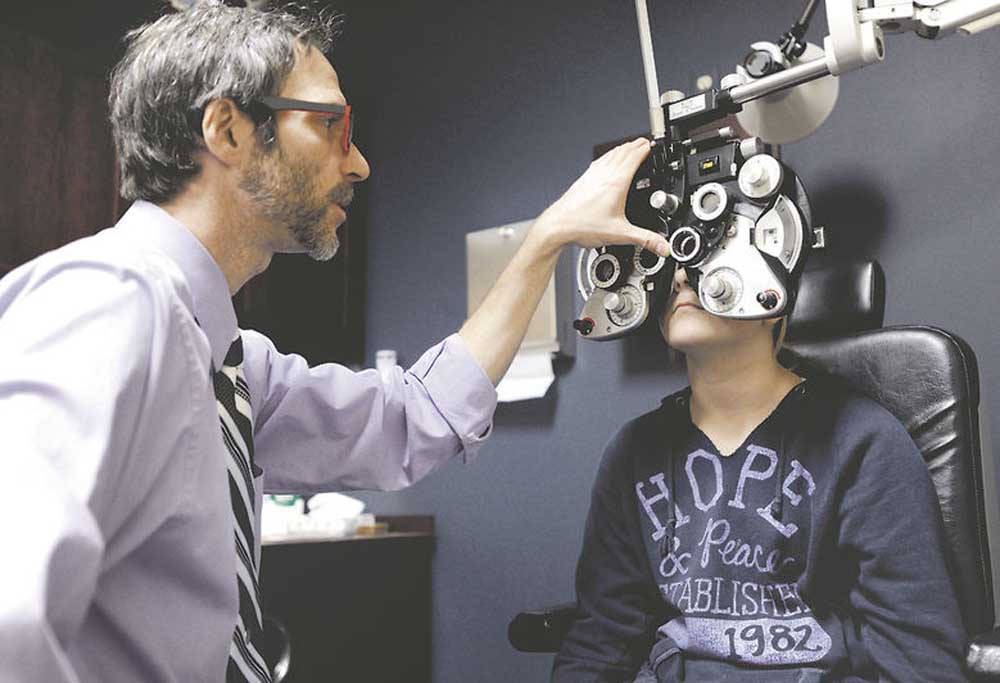IRS changes flexible spending rules
Published 4:52 pm Friday, November 15, 2013

- Michael Coffman, of Coffman Vision Clinic, checks the vision of Erin Conrad, 11, during her annual eye exam. His clinic normally gets busy toward the end of the year as patients try to use up their medical flexible spending accounts, but new IRS regulations will allow up to $500 in such accounts to roll over to the next year.
Every year around mid-October, Coffman Vision Clinic in Bend gets busy. Really busy.
It’s not some freak case of collective vision impairment. It’s people trying to use up the money that’s left in their flexible spending accounts, untaxed money people can save from their paychecks to spend on things that aren’t covered under their health insurance.
Trending
Things like, say, glasses. That’s what most of Coffman Vision Clinic’s customers tend to buy in November and December, said Optical Manager Allysyn Beebe.
“They’ve already come in for their eye exam earlier and they just have money left to spend, so they come in and get more glasses,” she said.
Until recently, FSA money automatically became unavailable at the end of the user’s insurance policy period, which for plans offered by most large employers happens Dec. 31. That generally prompts widespread mad rushes of people making appointments with their eye doctors, dentists or other providers before the end of the year. Leftover money typically goes back to the employer.
The U.S. Internal Revenue Service and Treasury Department on Oct. 31 released new rules designed to put a stop to the typical “use-it-or-lose-it” mantra and the stress it entails.
Now, employers that offer health FSAs can choose to allow up to $500 to roll over to the following year. And they can start right away.
“They could do it now,” said Carolyn Jarschke, president and CEO of QVI Risk Solutions in Bend, which administers FSAs for employers. “We’re going to scramble to make it happen, but they could do it.”
Trending
An estimated 14 million Americans participate in health FSAs through their employers, according to a news release announcing the change. They cover a wide range of expenses, such as dental treatments, corrective eyewear, hearing aids, psychiatric care, transportation related to medical care and abortions as well as deductibles and copayments.
Examples of excluded services include cosmetic surgery, gym memberships, controlled substances and nutritional supplements.
Lots of people have been hesitant to participate in FSAs because they don’t want to overestimate the amount of money they’ll use from the account, Jarschke said. Others don’t put enough money into the accounts and miss out on the potential tax benefit, she said.
The new rule likely will encourage more employees and employers to embrace FSAs, Jarschke said. The benefits go both ways: Neither the employee nor the employer pays taxes on the money that goes into the accounts, she said.
But often, trying to convince people of that isn’t so easy, said Patrick O’Keefe, owner of Cascade Insurance Center in Bend.
“It always amazes me when people have a flexible spending account available to them and they don’t make use of it,” he said.
For people who are unsure, O’Keefe said he generally recommends putting $10 per month into an FSA. Once they do, they’ll probably end up adding more when they realize how much expenses accumulate throughout the year, he said.
“I tell people, ‘You have a choice: You can earn $1 and have 75 cents to spend, or you can earn $1 and have $1 to spend,’” O’Keefe said. “Some people have a hard time grasping that. They think they can’t afford to put that money aside, not realizing that they get more of it if they put that money aside.”
Don Klippenes, owner of Health Insurance Strategies in Bend, shares that frustration. He guesses that less than 1 percent of people put money in FSAs, and those who do tend to put in less than $500. The maximum allowed is $2,500 annually, or $3,000 with the $500 that rolls over.
By Klippenes’ calculation, putting money into an FSA saves roughly 31 cents on the dollar when state and federal taxes are factored in. That’s on the order of $360 in savings per year for an employee who puts in $100 per month, he said.
“It’s a difficult concept for us to get our minds around unless we talk through it,” Klippenes said.
Most larger employers aren’t likely to provide the rollover option by the end of this year, given the short window before Jan. 1, said Kate Thomas, a local benefits consultant representing Aflac. That’s because making the administrative change and getting the word out to employees takes a long time. Smaller employers, however, might be able to pull it off in time.
“It’s very late in the game,” she said.
Bend Memorial Clinic, for example, has opted to provide the rollover option for its more than 550 employees, said Thomas, who administers BMC’s FSA program. BMC employees won’t be able to roll over FSA money until Jan. 1, 2015.
Employers already have been able to give their employees a 75-day grace period after their plans expire to get reimbursed for services or items. The catch, though, is that they must have made the purchases before the plan expired. With the change, employers will need to choose between the grace period and the new rollover option.
With all of the health care changes coming down from the Affordable Care Act recently, O’Keefe said he wouldn’t be surprised if some employers don’t opt for the rollover.
“It’s just, like, one more thing that they just don’t feel like dealing with at the moment,” he said.
That won’t be the case at Mid Oregon Credit Union, which employs 64 people at its five branches.
Kyle Frick, Mid Oregon’s vice president of marketing and community relations, said the credit union just got the IRS notice three days ago and already approved it. Now, the credit union is just waiting for its FSA administrator to prepare for the new rollover option before it spreads the word to employees, he said.
The “use-it-or-lose-it” rule made things difficult for people who couldn’t always plan ahead with their spending, Frick said. The new rule should alleviate that.
“I think most financial people would recommend if there’s any way to lower your tax burden and increase tax-exempt spending, you should probably do your best to take advantage of that,” he said.
The new rollover option does not, however, apply to dependent care or other cafeteria plan options, Jarschke said.
Back at Coffman Vision Clinic, Beebe said she thinks the rollover option will ease the rush of last-minute appointments.
As of last week, though, she wasn’t seeing any sign of slowing yet.
“I always wonder why everybody waits until the last minute,” Beebe said, “but we’re used to it.”








